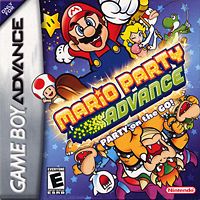Mario Party Advance

| |
| Mario Party Advance | |
| Developer | Hudson Soft |
| Publisher | Nintendo |
| System | Game Boy Advance, Wii U Virtual Console |
| Release Date | Game Boy Advance JP January 13, 2005 US March 28, 2005 EU June 10, 2005 Wii U Virtual Console US/PAL December 25, 2014 JP October 28, 2015 |
| Genre | Party |
| Gallery | GH Gallery |
| Rating | ESRB: E |
Mario Party Advance is a Game Boy Advance spin-off of the Mario Party games that was released in 2005.
Story[edit]
Mario and his friends have just arrived in Party World to have a fun time when Bowser arrives and scatters all of the minigames and Gaddgets. Mario and the others must explore Shroom City to gather them all and restore peace to the Party World.
Gameplay[edit]
The game works quite differently from the console Mario Party games, being oriented more for single players. Mario, Luigi, Yoshi and Princess Peach are the only playable characters.
The main mode is called Shroom City and is represented as a board containing several different environments. The player's character rides a car while traversing the board, and their goal is to complete a total of 50 quests for the characters living on different spaces. Instead of having a set number of turns, the player has a limited number of mushrooms that are used up each time that a player has to roll a dice bock. If a player runs out of mushrooms, they get a game over and must restart. When this happens, the player will lose progress of any quests that have not been completed, but they will retain data of any completed quests and have the option to switch characters, as some quests are only available for certain characters.
By completing quests, players could also earn different Gaddgets, which could be used to play short minigames in another mode. The content of the quests themselves vary from minigames to relaying messages between characters or solving puzzles or riddles for characters. Minigames are also played occasionally while traversing the board or by landing on M spaces and are completed to earn extra mushrooms. In this game, minigames primarily consist of challenges presented in a 2-D sidescrolling style, as opposed to the 3-D style of the other Mario Party games. The board also has Minus Spaces, through which players can lose mushrooms.
Other modes included Play Land (for playing or giving away minigames and Gaddgets), Party Land (for multuplayer minigames) and Challenge Land (where coins can be earned by playing minigames). Some minigames and Gaddgets can be played by four players, but otherwise only two players could compete in Duel Minigames. The original released of the game also came with a Bonus Board, a physical paper board that could be used to physically play a four-player game of Mario Party, with the game being capable of being used for the dice and for playing minigames.
Legacy[edit]
Ports/Remakes[edit]
- In late 2014 (2015 for Japan), it was released for download on the Wii U as part of the Wii U Virtual Console.
Sequels[edit]
The next Mario Party game to be released was Mario Party 7. In terms of handheld Mario Party games, it was followed up by Mario Party DS, which used more traditional Mario Party-style gameplay.
| Titles in the Mario Party series |
|---|
| Mario Party - 2 - 3 - 4 - 5 - 6 - 7 - 8 - 9 - 10 - Super Mario Party - Superstars Advance - Mario Party-e - DS - Island Tour - Star Rush - The Top 100 - Korokoro Party - 2 |